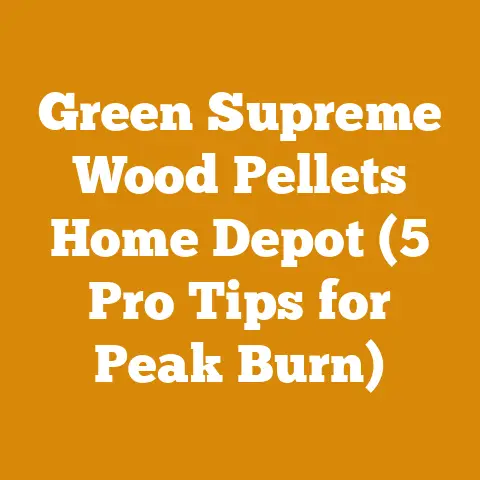Garage Pellet Stove Warm-Up Time (BTU Insights for Woodworkers)
In recent years, I’ve noticed a growing trend among woodworkers and homeowners alike: the increasing popularity of pellet stoves as a supplemental heating source, particularly in garages and workshops. This shift isn’t just about saving on heating bills; it’s also about creating a comfortable and efficient workspace, especially during those long winter months when I’m often knee-deep in woodworking projects. The big question everyone seems to be asking is: “How long will it take to warm up my garage with a pellet stove, and what BTU output do I really need?” Let’s dive deep into understanding garage pellet stove warm-up times and BTU considerations, drawing from my own experiences and observations over the years.
Understanding Garage Pellet Stove Warm-Up Time: A Woodworker’s Guide
Choosing the right pellet stove for your garage or workshop involves more than just picking the cheapest model. It’s about understanding the interplay between BTU output, garage size, insulation, and, of course, your tolerance for cold. I remember one particularly harsh winter where I tried to tough it out in my unheated garage. Let’s just say my fingers were so numb I couldn’t even hold a chisel properly. That’s when I decided to invest in a pellet stove, and it’s been a game-changer ever since.
What is BTU and Why Does It Matter?
BTU, or British Thermal Unit, is the standard unit for measuring heat output. One BTU is the amount of energy required to raise the temperature of one pound of water by one degree Fahrenheit. In the context of pellet stoves, BTU ratings indicate how much heat the stove can produce per hour.
- BTU and Garage Size: A larger garage will naturally require a higher BTU output to heat effectively.
- BTU and Insulation: A well-insulated garage will retain heat better, requiring less BTU output to maintain a comfortable temperature.
- BTU and Climate: Colder climates will necessitate higher BTU outputs to counteract heat loss.
Factors Affecting Garage Pellet Stove Warm-Up Time
Several factors influence how quickly a pellet stove can warm up your garage. Understanding these factors is crucial for selecting the right stove and optimizing its performance.
- BTU Output of the Stove: This is the most obvious factor. A higher BTU output means more heat generated per hour, leading to faster warm-up times.
- Garage Size and Layout: Larger garages take longer to heat. Open layouts may also lead to heat loss and uneven temperature distribution.
- Insulation Quality: Poorly insulated garages lose heat rapidly, increasing warm-up times and overall heating costs.
- Outdoor Temperature: The colder it is outside, the longer it will take to warm up the garage.
- Initial Garage Temperature: If the garage is already somewhat warm, the warm-up time will be shorter.
- Pellet Quality: Higher quality pellets burn more efficiently, producing more heat and reducing warm-up times. I’ve found that hardwood pellets generally outperform softwood pellets in terms of heat output and burn time.
- Stove Efficiency: The efficiency rating of the stove indicates how much of the fuel’s energy is converted into usable heat. Higher efficiency stoves warm up spaces faster and use less fuel.
- Stove Features: Some pellet stoves have features like programmable thermostats and automatic ignition, which can improve warm-up times and overall convenience.
Estimating Warm-Up Time: A Practical Approach
While it’s impossible to provide an exact warm-up time without knowing all the variables, I can offer a practical approach to estimate it. This involves calculating the heating load of your garage and then determining the appropriate BTU output for your pellet stove.
- Calculate Garage Volume: Measure the length, width, and height of your garage in feet. Multiply these dimensions to get the volume in cubic feet. For example, a 20ft x 20ft x 10ft garage has a volume of 4,000 cubic feet.
-
Determine Insulation Factor: This is a subjective assessment of your garage’s insulation quality. Use the following guidelines:
- Poor Insulation: Uninsulated walls and ceiling, single-pane windows.
- Average Insulation: Insulated walls (R-13), uninsulated ceiling, single-pane windows.
- Good Insulation: Insulated walls (R-19), insulated ceiling (R-30), double-pane windows.
-
Estimate Temperature Difference: Determine the desired temperature increase in your garage. For example, if you want to raise the temperature from 30°F to 65°F, the temperature difference is 35°F.
-
Calculate Heating Load: Use the following formula to estimate the heating load in BTU/hour:
Heating Load = Garage Volume x Temperature Difference x Insulation FactorHere are some typical insulation factors:
- Poor Insulation: 8 BTU/hour per cubic foot per degree Fahrenheit
- Average Insulation: 6 BTU/hour per cubic foot per degree Fahrenheit
- Good Insulation: 4 BTU/hour per cubic foot per degree Fahrenheit
For our example garage (4,000 cubic feet, average insulation, 35°F temperature difference):
Heating Load = 4,000 x 35 x 6 = 840,000 BTU/hourSince this is a very large number, we need to divide it by 60 to get BTU/minute:
Heating Load = 840,000 / 60 = 14,000 BTU/minuteThis means you need a stove that can deliver approximately 14,000 BTU per minute to achieve the desired temperature increase in one minute. Now, let’s say the pellet stove is rated at 60,000 BTU per hour, so about 1,000 BTU per minute. The warm-up time can be estimated as:
Warm-Up Time = 14,000 BTU/minute / 1,000 BTU/minute = 14 minutes5. Select Appropriate Pellet Stove: Choose a pellet stove with a BTU output that matches or exceeds your calculated heating load. It’s always better to err on the side of a slightly higher BTU output, as you can always adjust the stove’s settings to reduce heat output.
Example Scenario:
Let’s say I have a 2-car garage (20ft x 24ft x 8ft) with average insulation and I want to raise the temperature from 40°F to 65°F (a 25°F difference).
- Garage Volume: 20ft x 24ft x 8ft = 3,840 cubic feet
- Insulation Factor: 6 (average)
- Temperature Difference: 25°F
- Heating Load: 3,840 x 25 x 6 = 576,000 BTU/hour or 9,600 BTU/minute
I would need a pellet stove that can deliver at least 9,600 BTU/minute. If I choose a stove with a 50,000 BTU/hour rating (approximately 833 BTU/minute), the estimated warm-up time would be:
Warm-Up Time = 9,600 / 833 = 11.5 minutes
Optimizing Warm-Up Time: Practical Tips
Even with the right BTU output, there are several things you can do to optimize your garage pellet stove’s warm-up time.
- Improve Insulation: Adding insulation to walls, ceilings, and doors can significantly reduce heat loss and shorten warm-up times. Consider using fiberglass batts, spray foam, or rigid foam boards.
- Seal Air Leaks: Caulk around windows and doors to prevent drafts. Use weather stripping to seal gaps under doors.
- Use a Programmable Thermostat: Set the thermostat to start heating the garage before you plan to use it. This ensures a comfortable temperature when you arrive.
- Install a Ceiling Fan: A ceiling fan can help circulate warm air and distribute it more evenly throughout the garage.
- Preheat the Garage: If possible, preheat the garage with a portable electric heater before starting the pellet stove. This can reduce the initial heating load and shorten warm-up time.
- Use High-Quality Pellets: As mentioned earlier, high-quality pellets burn more efficiently and produce more heat. Look for pellets with a low ash content and a high BTU rating.
- Regular Maintenance: Keep your pellet stove clean and well-maintained. A dirty stove will operate less efficiently and take longer to warm up. Clean the burn pot, heat exchanger, and exhaust vent regularly.
Case Study: My Own Garage Pellet Stove Experience
When I first installed a pellet stove in my garage, I made a few mistakes that prolonged the warm-up time. I initially underestimated the size of my garage and purchased a stove with a lower BTU output than I needed. I also failed to properly insulate the garage, resulting in significant heat loss.
After realizing my errors, I upgraded to a higher BTU stove and added insulation to the walls and ceiling. I also sealed air leaks around the windows and doors. These improvements made a huge difference in warm-up time and overall heating efficiency. Now, my garage warms up much faster, and I can comfortably work in it even on the coldest days.
Common Mistakes to Avoid
- Underestimating BTU Needs: This is the most common mistake. Always err on the side of a slightly higher BTU output.
- Ignoring Insulation: Insulation is crucial for retaining heat and reducing warm-up times.
- Using Low-Quality Pellets: Cheap pellets may save you money upfront, but they often burn less efficiently and produce more ash.
- Neglecting Maintenance: Regular maintenance is essential for optimal performance and longevity.
- Failing to Seal Air Leaks: Air leaks can cause significant heat loss and prolong warm-up times.
- Improper Stove Placement: Place the stove in a central location to ensure even heat distribution.
- Overlooking Safety: Always follow the manufacturer’s instructions and local building codes when installing and operating a pellet stove.
Safety Considerations
Pellet stoves are generally safe to operate, but it’s important to follow certain safety precautions to prevent accidents and ensure optimal performance.
- Install a Carbon Monoxide Detector: Carbon monoxide is a colorless, odorless gas that can be deadly. Install a carbon monoxide detector in your garage and test it regularly.
- Maintain Proper Ventilation: Ensure that the stove is properly vented to the outside. Never operate a pellet stove in an enclosed space without adequate ventilation.
- Keep Flammable Materials Away: Keep flammable materials such as gasoline, paint, and wood shavings away from the stove.
- Clean the Stove Regularly: Clean the burn pot, heat exchanger, and exhaust vent regularly to prevent buildup of ash and creosote.
- Follow Manufacturer’s Instructions: Always follow the manufacturer’s instructions for installation, operation, and maintenance.
- Have the Stove Professionally Inspected: Have the stove professionally inspected annually to ensure that it is operating safely and efficiently.
Pellet Stove Maintenance Schedule
To keep your pellet stove running efficiently and safely, I recommend following this maintenance schedule:
- Daily: Empty the ash pot and clean the burn pot.
- Weekly: Clean the heat exchanger tubes and inspect the exhaust vent for obstructions.
- Monthly: Inspect the air intake and clean the blower motor.
- Annually: Have the stove professionally inspected and cleaned.
Choosing the Right Pellet Type
The type of pellet you use can significantly impact the performance of your pellet stove. There are two main types of pellets: hardwood and softwood.
- Hardwood Pellets: Hardwood pellets are made from dense hardwoods such as oak and maple. They typically have a higher BTU rating and produce less ash than softwood pellets.
- Softwood Pellets: Softwood pellets are made from softwoods such as pine and fir. They are generally less expensive than hardwood pellets, but they may not burn as efficiently.
I generally prefer hardwood pellets for their higher heat output and lower ash content. However, softwood pellets can be a good option if you’re on a tight budget. Regardless of the type of pellet you choose, make sure it is certified by the Pellet Fuels Institute (PFI) to ensure quality and consistency.
Pellet Storage Tips
Proper pellet storage is essential for maintaining their quality and preventing moisture absorption.
- Store Pellets in a Dry Place: Moisture can cause pellets to break down and burn less efficiently. Store pellets in a dry, well-ventilated area.
- Use a Pellet Storage Container: A pellet storage container can protect pellets from moisture and pests.
- Elevate Pellets Off the Ground: Elevate pellets off the ground to prevent moisture from seeping in.
- Rotate Pellet Stock: Use older pellets first to prevent them from deteriorating over time.
Alternative Heating Solutions for Garages
While pellet stoves are a great option for heating garages, there are other alternatives to consider.
- Electric Space Heaters: Electric space heaters are portable and easy to use. However, they can be expensive to operate, especially for large garages.
- Propane Heaters: Propane heaters are more powerful than electric space heaters and can heat larger spaces more quickly. However, they require a propane tank and proper ventilation.
- Natural Gas Heaters: Natural gas heaters are a good option if you have a natural gas line in your garage. They are efficient and relatively inexpensive to operate.
- Infrared Heaters: Infrared heaters heat objects directly, rather than heating the air. This can be a good option for spot heating specific areas of the garage.
Ultimately, the best heating solution for your garage will depend on your specific needs and budget.
Advanced Tips for Efficient Pellet Stove Operation
Beyond the basics, here are some advanced tips I’ve learned over the years for maximizing the efficiency of your pellet stove:
- Adjust Airflow Settings: Experiment with the airflow settings on your stove to find the optimal balance between heat output and burn time.
- Use a Barometric Damper: A barometric damper can help regulate the draft in your chimney and improve combustion efficiency.
- Install a Heat Shield: A heat shield can protect walls and other surfaces from excessive heat.
- Consider a Pellet Stove Insert: If you have an existing fireplace, consider installing a pellet stove insert. This can be a more efficient and aesthetically pleasing option than a freestanding pellet stove.
- Monitor Pellet Consumption: Keep track of your pellet consumption to identify potential problems and optimize your heating strategy.
Troubleshooting Common Pellet Stove Problems
Even with proper maintenance, pellet stoves can sometimes experience problems. Here are some common issues and how to troubleshoot them:
- Stove Won’t Start: Check the power supply, fuel supply, and ignition system.
- Stove Produces Little Heat: Check the fuel quality, airflow settings, and heat exchanger.
- Stove Smokes Excessively: Check the exhaust vent for obstructions and ensure proper ventilation.
- Stove Shuts Down Unexpectedly: Check the safety sensors and fuel supply.
If you’re unable to resolve the problem yourself, consult a qualified pellet stove technician.
The Future of Pellet Stove Technology
Pellet stove technology is constantly evolving, with new features and improvements being introduced all the time. Some of the latest trends include:
- Smart Stove Technology: Smart stoves can be controlled remotely via smartphone or tablet.
- Self-Cleaning Stoves: Self-cleaning stoves automatically remove ash and other debris, reducing maintenance requirements.
- Multi-Fuel Stoves: Multi-fuel stoves can burn a variety of fuels, including pellets, corn, and wood chips.
- High-Efficiency Stoves: High-efficiency stoves convert a greater percentage of fuel energy into usable heat, reducing fuel consumption and emissions.
As technology continues to advance, pellet stoves will become even more efficient, convenient, and environmentally friendly.
Addressing Specific Woodworking Challenges
For woodworkers, a warm garage isn’t just about comfort; it’s about the quality of our work. Cold temperatures can affect wood glue adhesion, paint drying times, and even the way wood behaves when being cut and shaped.
- Glue Adhesion: Many wood glues require a minimum temperature of 50°F (10°C) for proper bonding.
- Paint Drying: Cold temperatures can significantly slow down paint drying times and affect the finish quality.
- Wood Movement: Wood expands and contracts with changes in temperature and humidity. Maintaining a consistent temperature in the garage can help minimize wood movement and improve the accuracy of your woodworking projects.
By investing in a pellet stove and properly insulating your garage, you can create a more stable and predictable environment for your woodworking projects.
Legal and Regulatory Considerations
Before installing a pellet stove in your garage, it’s important to check local building codes and regulations. Some jurisdictions may have restrictions on the type of stoves that can be installed, as well as requirements for venting and clearances.
Additionally, you may need to obtain a permit before installing a pellet stove. Contact your local building department for more information.
Pellet Stove Brands and Models: My Recommendations
Over the years, I’ve had the opportunity to work with and observe a variety of pellet stove brands and models. Here are a few that I would recommend based on my experience:
- Harman: Harman is a well-known brand that produces high-quality, reliable pellet stoves. Their stoves are known for their efficiency and durability.
- Lopi: Lopi is another reputable brand that offers a wide range of pellet stoves to suit different needs and budgets.
- England Stove Works: England Stove Works produces affordable pellet stoves that are a good option for those on a tight budget.
- Pelpro: Pelpro offers a variety of pellet stoves with different features and BTU outputs.
When choosing a pellet stove, consider your specific needs, budget, and the size of your garage. Read online reviews and talk to other pellet stove owners to get their recommendations.
Quantifying Success: Measuring Your Garage Heating Performance
After installing your pellet stove, it’s important to measure its performance to ensure that it’s meeting your needs and operating efficiently. Here are some metrics to track:
- Warm-Up Time: How long does it take to raise the temperature of your garage to your desired level?
- Fuel Consumption: How many bags of pellets do you use per week or month?
- Temperature Consistency: Is the temperature in your garage consistent throughout the day?
- Cost of Operation: How much does it cost to heat your garage with a pellet stove compared to other heating methods?
By tracking these metrics, you can identify areas for improvement and optimize your heating strategy.
Conclusion: A Warm Garage is a Productive Garage
Investing in a pellet stove for your garage can be a game-changer, especially if you’re a woodworker or someone who spends a lot of time in their garage during the colder months. By understanding the factors that affect warm-up time and BTU requirements, you can choose the right stove for your needs and optimize its performance. Remember to prioritize safety, maintenance, and proper pellet storage to ensure years of reliable and efficient heating. A warm garage isn’t just about comfort; it’s about creating a productive and enjoyable workspace where you can pursue your passions.






